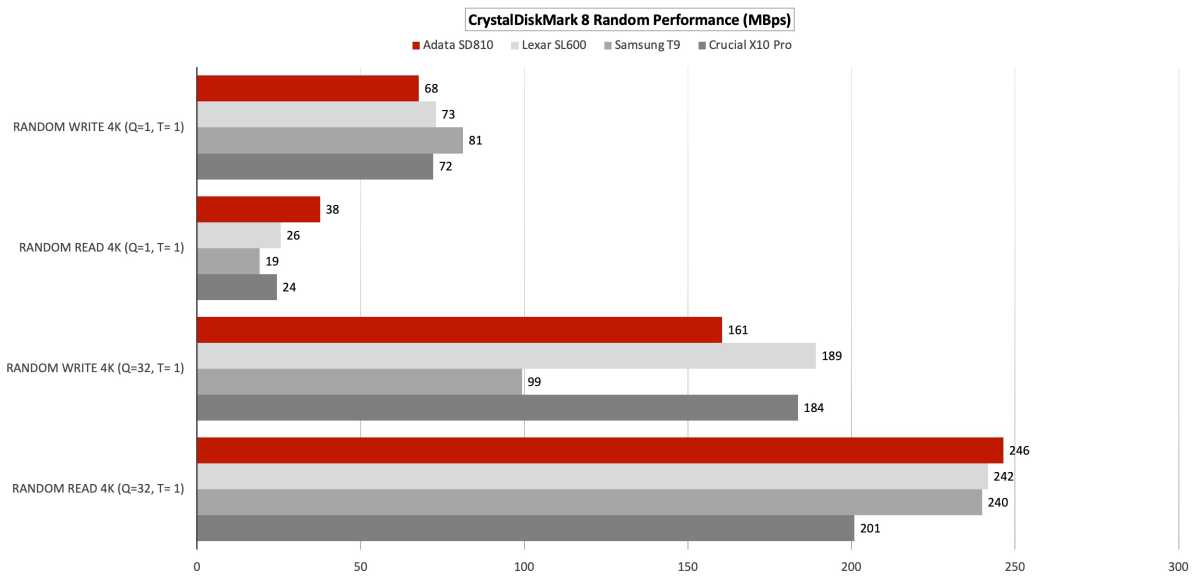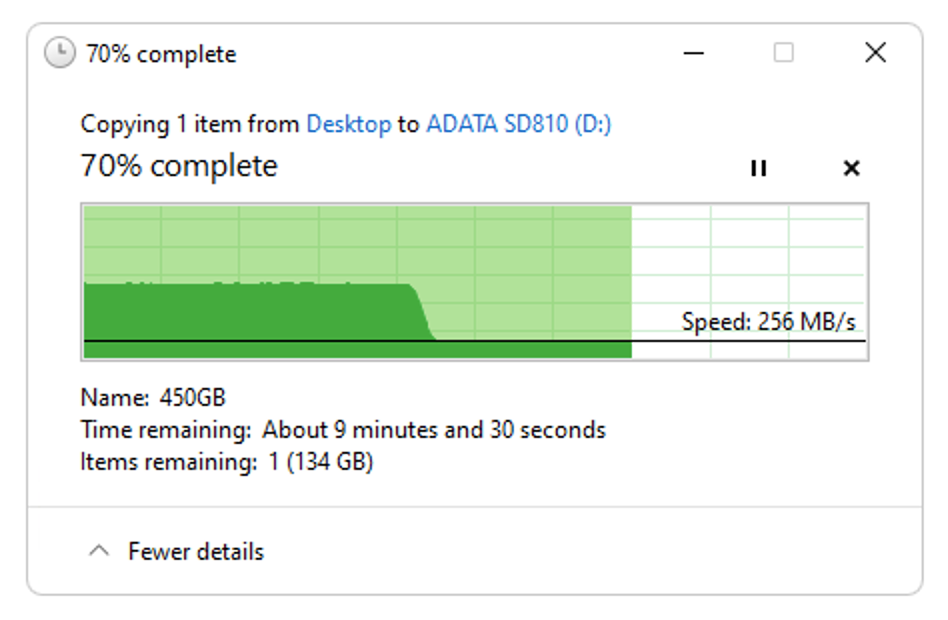Expert’s Rating
Pros
- Good overall 20Gbps performance
- Slim, good-looking form factor
- Competitively priced, especially the 4TB capacity
Cons
- Slow 450GB write due to secondary cache exhaustion
Our Verdict
The Adata SD810 is an affordable, 20Gbps USB SSD, and currently a bargain in the 4TB capacity. It breezed through the majority of our tests, but slowed drastically in the 450GB write, which will only affect the rare user.
Price When Reviewed
1TB: $100 I 2TB: $160 I 4TB: $300
Best Prices Today: Adata SD810 20Gbps USB SSD
$99.99
The Adata SD810 was a bit of déjà vu for me, sporting the same sculpted form factor of the previously reviewed SE800 and SE880. Being black, it’s darker than it’s cousins, though it ships in hot pink box — that’ll get your attention in the retail space.
As far as I know, there’s no partnership with T-Mobile, but the SD810 is still a worthy competitor for your 20Gbps USB storage buck.
Further reading: See our roundup of the best external drives to learn about competing products.
What are the Adata SD810’s features?
The Adata SD810 is a svelte USB 3.2×2, 20Gbps external SSD measuring around 2.84-inches long, by 1.72-inches wide, by 0.48-inches thick. It weighs around 1.4 ounces and is basically a rectangle with curved sides and large, sculpted indentations running from end cap to end cap.
Speaking of which, the captive end cap covering the Type-C port wasn’t particularly easy to remove the first time. Partly due to not knowing how much force to employ — I try not to break or disfigure the test products.
While Adata wasn’t forthcoming on the actual internals in use, given the 2GBps read performance, they’re NVMe; and with sustained writes dropping to slightly below 250MBps when secondary cache (NAND written as SLC) ran out, the NAND is almost certainly QLC.
Adata warranties the SD810 for five years — the norm, though that assumes you don’t use a drill press on the unit or try to write exabytes worth of data to it every six months. Big hint on the latter: You’ll wear out the drive long before that.
The 4TB version of the SD810 is a particularly good buy — as long as your workload doesn’t entail the regular writing of very large files.
How much does the Adata SD810 cost?
At the time of this writing, Adata said the SD810 SSD was available in 500GB, 1TB, 2TB, and 4TB capacities for $60, $100, $160, and $340, respectively. Those prices are about average, with the exception of the 4TB, which is a rather nice bargain — even before you take into account that Amazon currently has the 4TB SD810 listed at just $300!
The SD810 was very fast at most of the benchmarks, but that can be said of most 20Gbps USB 3.2×2 SSDs. For everyday use, it’s aces. However, it’s not the drive you want for heavy-duty video editing and the like. Its NAND (likely QLC) writes at only 250MBps once the secondary cache runs out.
Right-click and select “Open image in new tab” to see more detail.
Just FYI, secondary caching on SSDs is done by writing the NAND as one-bit SLC (writing a single bit takes far less time) rather than the full 4-bit QLC (or 3-bit TLC). Far less error-checking is required when there are only two possible voltage states: charged/not-charged, rather than the eight states with TLC and 16 with QLC.
The SD810’s random 4K performance was generally on target for a 20Gbs USB 3.2×2 (there is also USB4 20Gbps) SSD.

While the SD810 did well in our 48GB transfers, there was nothing to write home about. At least for a 20Gbps USB SSD.

Where the SD810 fell off the pace considerably was writing a single 450GB file. It ran out of secondary cache around the halfway mark and write speed dropped to around 250MBps. Running dry on secondary cache that quickly is a surprise with a 2TB SSD.

You can see where the slowdown actually occurred in the screen capture below.

Overall, the Adata SD810’s performance is more than adequate except for the most extreme situations. Unless you regularly write more than 250GB worth of data, don’t worry about speed.
A note for Mac users: Current Macs, even those that support USB4 20Gbps don’t support USB 3.2×2, only USB 3.1. The SD810 and all others of its ilk will run at 10Gbps on a Mac. Don’t ask me why. Ask Apple and the USB Forum.
Should you buy the Adata SD810?
The Adata SD810 is a good-looking, affordable USB 20Gbps SSD that will work for anyone not looking to write huge amounts of data on a regular basis. Not the best, but hardly the worst.
How we test
Drive tests currently utilize Windows 11 (22H2) 64-bit running on an X790 (PCIe 5.0) motherboard/i5-12400 CPU combo with two Kingston Fury 32GB DDR5 modules (64GB of memory total). Intel integrated graphics are used. The 48GB transfer tests utilize an ImDisk RAM disk taking up 58GB of the 64GB total memory. The 450GB file is transferred from a Samsung 990 Pro 2TB, which also contains the operating system.
Each test is performed on a newly NTFS-formatted and TRIM’d drive so the results are optimal. Note that as any drive fills up, performance will decrease due to less NAND for secondary caching, and other factors.
The performance numbers shown apply only to the drive we were shipped as well as the capacity tested. SSD performance can vary with capacity due to more or fewer chips to read/write across and the amount of NAND available for secondary caching (writing TLC/QLC as SLC). Vendors also occasionally swap components. If you ever notice a large discrepancy between the performance you experience and that which we report (systems being roughly equal), by all means—let us know.


